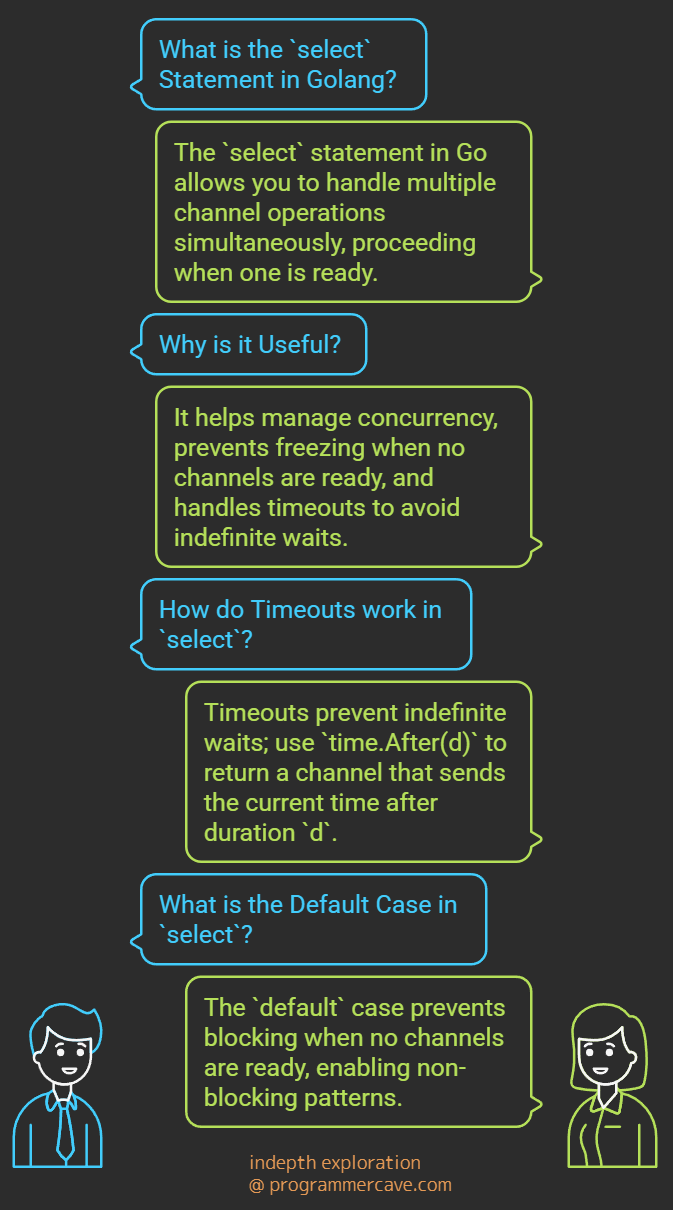Understanding the select Statement in Go
If you’re preparing for a software engineering interview and are new to Go (Golang), understanding the select statement is crucial. It’s a powerful tool for managing concurrency, especially when working with channels. This blog will explain everything you need to know about the select statement, including its syntax, how it works, and practical examples.
Key Takeaways
- The
selectstatement in Go allows you to handle multiple channel operations simultaneously. - It blocks until one of the cases is ready, or executes a
defaultcase if no channels are ready. - Use
time.After()for timeouts to avoid indefinite waits. - A
defaultcase ensures non-blocking behavior and prevents deadlocks. - Best practices include using
defaultfor non-blocking operations andtime.After()for timeout handling.

What is the select Statement?
The select statement in Go allows you to handle multiple channel operations at the same time. It waits for one or more communication operations (sending or receiving data on channels) to complete and proceeds when one of them is ready. If multiple cases are ready, it randomly picks one to execute.
Why is it Useful?
- Concurrency Management: Helps coordinate multiple goroutines by managing their communication through channels.
- Non-Blocking Behavior: Prevents your program from freezing when no channels are ready.
- Timeout Handling: Ensures your program doesn’t wait indefinitely for a channel operation.
Syntax of the select Statement
Here’s the basic structure of the select statement:
select {
case <-channel1:
// Code for receiving data from channel1
case data := <-channel2:
// Code for receiving data from channel2
case channel3 <- value:
// Code for sending data to channel3
default:
// Code for non-blocking fallback
}
Key Components:
select: Starts the block where multiple channel operations are evaluated.case <-channel: Waits for data to be received from a channel.case data := <-channel: Receives data from a channel and assigns it to a variable.case channel <- value: Sends data to a channel.default: Executes if no channels are ready (optional).
Blocking vs Non-Blocking Operations
Blocking Operations
In Go, channel operations can block until another goroutine is ready to communicate. For example:
Example of Blocking Receive:
func main() {
ch := make(chan int)
go func() { ch <- 12 }()
integerValue := <-ch
fmt.Println(integerValue) // Output: 12
}
- The
<-choperation blocks until another goroutine sends a value toch.
Example of Blocking Send:
func main() {
ch := make(chan int)
go func() { fmt.Println(<-ch) }()
ch <- 42
}
- The
ch <- 42operation blocks until another goroutine is ready to receive the value.
Non-Blocking Operations
To prevent blocking, you can use the default case in a select statement.
Example of Non-Blocking Receive:
func main() {
ch := make(chan int)
go func() { ch <- 42 }()
select {
case value := <-ch:
fmt.Println("Value received:", value)
default:
fmt.Println("No value received")
}
}
// Output: No value received
- If no value is available on
ch, thedefaultcase executes immediately.
Timeouts in select
Timeouts are essential for preventing your program from waiting indefinitely for a channel operation. You can use the time.After() function to implement timeouts.
Example of Timeout Handling:
func main() {
taskChannel := make(chan string, 1)
go func() {
time.Sleep(2 * time.Second)
taskChannel <- "Task completed"
}()
select {
case msg := <-taskChannel:
fmt.Println(msg)
case <-time.After(1 * time.Second):
fmt.Println("Timeout: Task took too long")
}
}
// Output: Timeout: Task took too long
How It Works:
time.After(d)returns a channel that sends the current time after durationd.- If the channel operation takes longer than the timeout, the timeout case executes.
Default Case in select
The default case ensures that your program doesn’t block when no channels are ready. It’s particularly useful for implementing non-blocking patterns.
Example of Default Case:
func main() {
channelOne := make(chan string)
channelTwo := make(chan string)
go func() {
time.Sleep(2 * time.Second)
channelOne <- "Message from channelOne"
}()
go func() {
time.Sleep(1 * time.Second)
channelTwo <- "Message from channelTwo"
}()
for {
select {
case messageOne := <-channelOne:
fmt.Println(messageOne)
return
case messageTwo := <-channelTwo:
fmt.Println(messageTwo)
return
default:
fmt.Println("Waiting for the messages...")
time.Sleep(500 * time.Millisecond)
}
}
}
Behavior:
- Prints “Waiting for the messages…” repeatedly until one of the channels sends data.
- Once data is received, it processes the message and exits.
Summary Table
| Feature | Description |
|---|---|
| Blocking Operations | Blocks until another goroutine is ready to send/receive data. |
| Non-Blocking Behavior | Use default case to prevent blocking when no channels are ready. |
| Timeout Handling | Use time.After() to set a timeout for channel operations. |
| Random Execution | If multiple cases are ready, select picks one randomly. |
| Practical Use Cases | Multiplexing channels, handling timeouts, and avoiding deadlocks. |
Conclusion
The select statement is a cornerstone of Go’s concurrency model. By mastering it, you can write efficient, responsive programs that handle multiple channel operations seamlessly. Whether you’re preparing for an interview or just learning Go, understanding select will give you a significant advantage in managing concurrency.